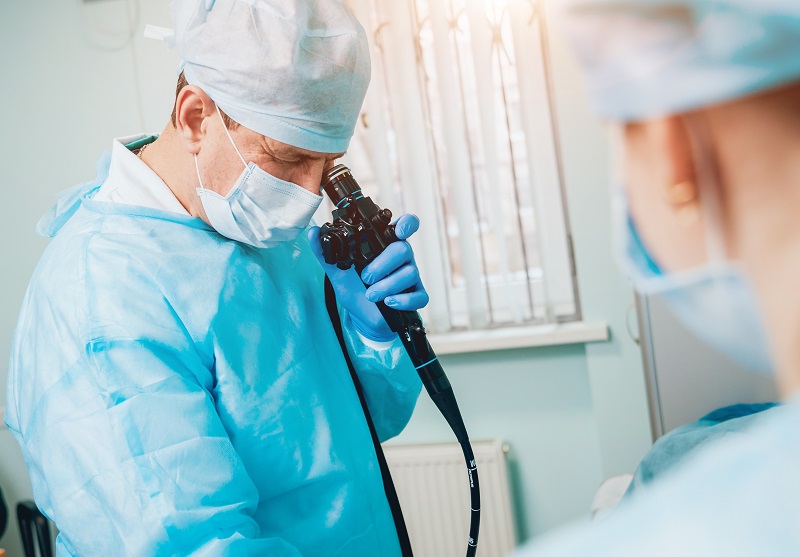Colonoscopy (Lower Gastrointestinal Endoscopy)
COLONOSCOPY
Colonoscopy is an examination of all colons (large intestines) by passing through the anus with a flexible tube with a camera at the end. The colonoscope is gently passed through the rectum and advanced to the junction of the large intestine and small intestine (cecum). From here, the small part of the small intestine (terminal ileum) is examined, because this area is where many diseases are occurred. Colonoscopy is very useful method for diagnosis of many diseases of the large intestines, and is more sensitive than both barium x-ray and computed tomography / MR.
WHY IS COLONOSCOPY MADE?
There are several reasons/indications for colonoscopy.
1. Investigating the causes of abdominal pain, management (diarrhea), constipation (constipation),
2. Diagnosis of colon polyps (polyps can be easily detected and removed during colonoscopy, thereby significantly reduced the risk of colon cancer),
3. Conditions that cause suspicion of colon cancer such as rectal bleeding, change in defecation habit, weight loss, abdominal pain,
4. For the diagnosis of inflammatory bowel disease
COLONOSCOPIC IMAGING
As a general rule, the higher the quality of the endoscope, the better and more accurate the results from the colonoscopy. During the procedure, lesions smaller than 1 cm, which are generally difficult to see, are examined. Modern endoscopy devices with high standard BLI and LCI imaging are used in our clinic.
PREPARATION OF COLONOSCOPY
For a quality colonoscopic examination, it is necessary to clean the bowels completely. You should use laxatives on the evening before the procedure (and early in the morning if necessary). Your doctor will inform you about aspirin, iron, insulin, etc. medications that you need to stop before the colonoscopy.
HOW TO EAT AND DRINK BEFORE COLONOSCOPY
A few days before the procedure, the patient should eat a diet with little fiber (lean meat, fish, cheese, eggs, pasta, rice.) Abundant fiber foods (fruits, vegetables, legumes, wholemeal foods) should be eaten as little as possible. The day before the procedure, lunch and dinner should be non-grained, juicy food. You can drink broths, chicken broths, tea-coffee without milk, apple-cherry juice. Your doctor and endoscopy nurse will provide detailed information on how to clean.
HOW IS DONE A COLONOSCOPY PROCEDURE?
During the procedure, light sedation is applied for the patient’s comfort. This sedation state is adjusted not to make the patient completely sleep like anesthesia performed in the operations, but to wake up immediately at the end of the procedure.
During the colonoscopy, it is constantly observed whether the patient has discomfort. At the same time, the patient’s heart rhythm, blood pressure, pulse, breathing, blood oxygen status are constantly monitored. After the procedure, the gas delivered to the intestines is absorbed and the process is completed so that the patient is not disturbed.
WHICH DISEASES ARE DETECTED BY COLONOSCOPY?
The most common diseases detected during a colonoscopy are:
diverticula
Inflammatory bowel diseases (ulcerative colitis, Crohn’s disease, microscopic colitis, E coli and camphylobacter diarea)
polyps
Cancer
DIVERTICULA
Diverticulas usually occurs in older people. It occurs due to the formation of small sacs in the colon wall. It is mostly seen in the left colon, and generally familial. The symptoms which are associated with the diverticula are abdominal pain, change in defecation habits (constipation or diarrhea, or both), rectal bleeding, fever and pain with infection.
COLON POLYPS
Polyps are small bumps raised from the colon wall. Some can turn into cancer if left untreated. But there are many types:
Sessile (without stalk) and pedunculated polyp
A pedunculated polyp is in the form of mushrooms, connected to the mucosa with a short or long stalk/peduncule. They can be easily resected during colonoscopy by cutting. A sessile polyp does not have a peduncule/stalk, and not so elevated from the surface. Such polyps are more difficult to detect and resect.
Most polyps are small and do not become cancerous. The most common type of polyp which do not become cancerous is hyperplastic polyp. The more important type is adenomatous polyps, because adenomatous polyps carry cancer risk according to their size and nature (tubuler or villous). Tubular adenomas carry the lowest risk for cancer, while villous adenomas are the highest risk. Tubulovillous adenomas are at risk in the middle of two types.
Serrated adenomas: Carries a high risk of cancer. They are flat, silent polyp, hard to see, and should be searched carefully.

